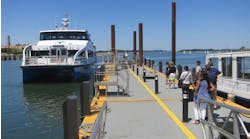In the Union Station of the not-too-distant-future, a 55-inch high-res screen flashes bus times in parallel with today’s deals at a Thai restaurant across town. You tap into that deal with your smartphone, which beams back user data into a real-time marketing analytics system housed a continent away from the Windy City but offering a closer look into customers’ habits than ever before. En route to your newfound lunch destination, you take a transfer on a bus through a neighborhood made more familiar by a display that integrates the bus route with GPS data.
Those are some of the promises of the coming wave of digital signage for advertising in mass transportation hubs. While that may not seem alien in comparison to what has been on display outside of big city stores or in airport terminals of late, more and more operators of bus and rail systems are upgrading to savvy digital ad signage, with the hope of better returns on sales pitches all around. There are questions about the true reach and impact of these computerized sales avenues, but there’s no doubt that transit authorities are giving them a shot.
“Over the last two years, we’ve put it at 40 percent, the increase of installations at transit venues,” said Clark Brown, SVP for sales at NEC Display Solutions, a display hardware provider and content software advisory. “A lot of that has been in the airport sector, but now, all transit systems are taking it to the next level. This is a huge revenue opportunity that I think we’re just starting to scratch the surface.”
Between 2010 and 2012, U.S. shipments of digital signage monitors and TVs to the transportation industry grew 48 percent to 101,607, according to a market analysis provided by IHS iSuppli Direct analyst Dragana Boras. A forecast from iSuppli transportation digital signage in the years ahead show steady growth through 2016, when the units are expected to top 156,000 units, a 54 percent boost from last year with a large chunk coming from the increased bus and rail advertising investment.
In a separate market analysis, Global Industry Analysts put transportation as one of the “emerging” categories among the digital signage horizontals, but still only a sliver in the larger overall $13.8 billion pie of sales anticipated by 2017, according to a seven-year forecast.
A prominent portion on the promise of the near future of digital hucksterism will be showcased in mid-February at the annual Digital Signage Expo, held in Las Vegas. While not relegated to transit alone — retail continues to rule the day with digital ads — there is a small but growing session track for mass transportation, including talks on network optimization, use of cutting edge video walls and signage project planning basics. Wrinkles and ripples in software mean all kinds of possibilities with displays, but there are a few that stand to materialize in the next year or so in the transit sector, according to front-line vendors.
Nimrod Halfon, senior consultant with signage vendor Four Winds Interactive, pointed out that, as trains, buses and rails are a few years behind their airport counterparts, their initial proposals for upgrades don’t always reflect current possibilities. That is quickly changing with systems enhancements, and Halfon predicts more interactive applications for self-service via digital ad displays, as well as a watershed of localized promotions that tend to do well with mass transit crowds.
Halfon said the most widespread enhancement might be “smarter” systems that integrate disparate information sources on the back end with the curious traveler on the front end.
“Providing as much information during a passenger’s travel experience will increase their satisfaction and decrease anxiety and frustration. Systems that can easily integrate a number of different data sources … will be necessary,” Halfon said.
Brown, who is moderating a panel at the Expo of use case successes and digital signage expectations in the years to come, was surprised through 2012 that ultra-thin, 55-inch displays became the hottest hardware item purchased by transit operators. To him, that indicates that transit managers want a “wow factor” with signage upgrades as well as advertising potential in their central terminal and congregation areas.
Bigger than those big video wall screens, though, will be the onslaught of analytics. Marketers and startups are enamored with the potential to cull business wisdom from various data points to and from digital signs. With leaps in analytic technology and methodology — think IBM’s “Jeopardy!” supercomputer Watson meets Jonah Hill’s character in “Moneyball” – Brown and others feel transit systems could prove an intriguing test case.
“We had a consultant speak to us nine months ago who felt like you could predict the future of purchases by what was on the screen,” he said.
For all of the bells and whistles with digital signage, there are some sirens sounding off with healthy skepticism. Dave Haynes, partner at The Preset Group, a consultancy specializing in digital signage projects, said he has seen some rays of pertinent use of digital signage in transportation. For instance, the connection of GPS and mapping applications from digital signs to transit hubs and inside of rail cars or buses addresses unique needs for both the traveling public and the business in town.
In terms of massive discoveries and marketing opportunities from commuter analytics, the Toronto-based Haynes is wary. Metrics can be tricky, as many people pass through a subway station each month, though they may be in a hurry and are certainly “customers” that may be counted multiple times. Furthermore, interactive displays may return just the info advertisers dread: an ad or sign is being wholly ignored. Even as investments and upgrades are flowing to these transit systems, Haynes said the advertising dollars may be taking a more direct route via mobile devices or limiting their contribution to what could be perceived as mass transit’s “down market.”
“Even the New York City Metro, which runs a lot of seven-figure income people to and from Lower Manhattan, has platforms and rail cars populated mostly by ads for career colleges and English language classes. That's the biggest media market in the world,” said Haynes.
In his annual predictions, digital signage author and Web analyst Keith Kelsen wrote recently that a big change he expects for the coming year relevant to transportation providers doesn’t surround hardware or software at all. It’s the long-standing ad agency struggle with great content. As the tech side of these signs matures, advertisers — and, by extension, the transit systems that house them — must have a tailored plan for this specific audience that expects “high quality” digital content but has a big risk of repetition and dismissal.
“The challenge is how to create content that is network wide, has continuity and is cost effective. Depending upon the type of network – whether it is point of sale, point of wait or point of transportation – it is the level of work and the amount of content that is needed to accomplish the refresh rate that makes a digital signage network successful,” Kelsen wrote.
Not burdened by technical challenges or content concerns, sophisticated digital advertising displays are popping up across the U.S.: at Amtrak stations in Washington, D.C., in rail installations on the Burlington Northern Santa Fe, on display in Buffalo through its Niagara Frontier Transit Authority.
The Massachusetts Bay Transportation Authority launched a pilot program on digital signage geared toward advertising in the last year, including two high-resolution outdoor screens at its South Station. MBTA, the rail, subway and bus line operator for the greater Boston area, has long had digital signs for wayfinding and has tinkered with other forms of out-of-the-box ad possibilities, like a short-lived audio broadcast at stations. Offering in-house information along with ads, the new smattering of digital signage has been a secondary initiative compared with another station move to bring “countdown” clocks for transit times across the system. But if the promises of millions in ad revenues shared in part with the Boston transit authority come through, MBTA officials appear likely to give a longer look at more digital ad signage, according to spokesman Joshua K. Robin.
“As we think for the future about advertising, it’s definitely something we’re looking at going toward,” Robin said. “We’re always looking for ways to enhance advertising from a revenue perspective.”
Global Industry Analysts:
http://www.prweb.com/releases/digital_signage_systems/displays_software/prweb8588648.htm
annual digital signage trends, Keith: http://www.digitalsignagetoday.com/article/205997/The-top-10-digital-signage-trends-ahead-for-2013-Pt-I-Commentary
Expo: http://www.digitalsignageexpo.net




